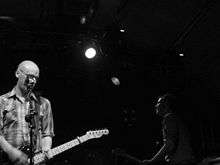I Concur
| I Concur | |
|---|---|
 | |
| Background information | |
| Origin | Leeds, West Yorkshire, England |
| Genres |
Post-Rock Alternative rock Indie |
| Years active | 2007–present |
| Labels | Club AC30 |
| Website | Official site |
| Members |
Tim Hann James Brunger Toby Page Chris Woolford |
I Concur is an alternative rock band from Leeds, West Yorkshire, England.
The band is known for using their lyrics to tell unusual stories from modern culture. Subject matter has previously focused on the Korean stem cell scientist Hwang Woo Suk (on "Decimal Places"), the building of the M62 motorway around Stott Hall Farm (on "Build Around Me") and the American TV series The Wire (on "Sobotka").[1]
Career
I Concur's their first gig took place at The Packhorse, Leeds, in January 2007 and in the subsequent May, the band released their debut EP "Whatever It's Going to Be".
Following a support with The Hold Steady,[2] I Concur were added to the independent record label, Dance To The Radio’s various artists compilation album, Out of the Woods and Trees,[3] then in March 2008, the band released a limited 7" double a-sided single, "Lucky Jack" / "Build Around Me", through Brew Records which was played by Huw Stephens on BBC Radio 1.[4] Following positive reviews,[5] and coverage in the NME, I Concur were invited to record a session for Huw Stephens' BBC Introducing show at the Maida Vale studios.[6]
The following July, BBC Introducing announced that I Concur would play at the Reading and Leeds Festival.[7] The band then released their next single, "Oblige", produced by Tom Woodhead of ¡Forward, Russia!, in October 2008.[8]
In September 2009, I Concur announced that had signed with the London-based record label, Club AC30, and the band's debut album, Able Archer, and new single, "Sobotka", were released the following October.[9]
Following positive reviews of the album [10] the band took time away from performing to focus on writing new material.
The band released its second album, Burial Proof[11] in mid-2012.
Members
- Tim Hann - guitar, vocals
- James Brunger - drums, vocals
- Toby Page - bass
- Chris Woolford - guitar
Discography
Albums
- Able Archer (2009) - Club AC30
- "Burial Proof" (2012)
EPs
- "Whatever It's Going to Be" (2007) - self released
Singles
- "Lucky Jack" / "Build Around Me" (2008) - Brew Records
- "Oblige" / "Captors" (2008) - Brew Records
- "Sobotka" / "Iterate This" (2009) - Club AC30
Compilation albums
- Out of the Woods and Trees (2007) - Dance To The Radio
- Brew Records, Volume 1 - (2007) - Brew Records
- Compilation Number 2 - (2008) - On The Bone
References
- ↑ – BBC Leeds Local Bands - Motorway madness!
- ↑ Leeds Music Scene – Hold Steady @ Cockpit
- ↑ – Dance To The Radio - DTTR IV - Out Of The Woods And Trees
- ↑ BBC - Radio 1 - Huw Stephens - Tracklistings
- ↑ - MySpace - I Concur
- ↑ - BBC Humber - BBC Introducing Maida Vale Weekender
- ↑ - Leeds Festival - BBC Introducing stage announced
- ↑ - i Concur: Oblige - Whisperin & Hollerin
- ↑ - I Concur Able Archer - Club AC30 website
- ↑ - Able Archer - The Fly
- ↑ - I Concur Burial Proof - Bandcamp